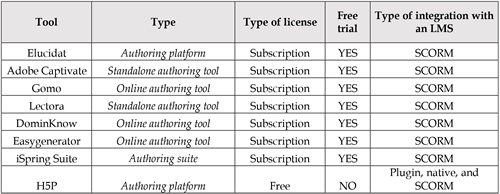
Source: self-made, 2019.
doi.org/10.15178/va.2021.154.e1224
RESEARCH
EVALUATION OF THE IMPLEMENTATION OF A LEARNING OBJECT DEVELOPED WITH H5P TECHNOLOGY
EVALUACIÓN DE LA IMPLEMENTACIÓN DE UN OBJETO DE APRENDIZAJE DESARROLLADO CON TECNOLOGÍA H5P
EVALIAÇÃO DA IMPLEMENTAÇÃO DE UM OBJETO DE APRENDIZAGEM DESENVOLVIDO COM TECNOLOGIA H5P
Sergio-Ramón Rossetti López .
Ma. Teresa García Ramírez2
Isaac-Shamir Rojas Rodríguez1
1University of Sonora. Mexico.
2Autonomous University of Querétaro. Mexico.
ABSTRACT
Learning objects are used as teaching materials and are intended to support teaching and learning processes. The objective of the article was to evaluate a learning object developed with the free software tool H5P to be used as support material in a course of Research Methodology in the Administration career at a public university located in the state of Sonora, Mexico. Based on a quantitative, descriptive, and cross-sectional study, the evaluation of the learning object was carried out on four dimensions: usefulness, impact, integration, and characteristics. The results obtained are derived from a pilot with 70 undergraduate students and show a positive assessment of the learning object, they also allow us to glimpse the potential and benefits of the H5P platform to generate all kinds of educational materials. With the findings of this intervention, a reference framework is available for future developments and implementations of learning objects with H5P.
KEY WORDS: Evaluation, Learning objects, Educational technology, H5P, Learning management system.
RESUMEN
Los objetos de aprendizaje son utilizados como materiales didácticos y tienen la finalidad de apoyar procesos de enseñanza y aprendizaje. El objetivo de este trabajo fue el de evaluar un objeto de aprendizaje, desarrollado con la herramienta de software libre H5P para ser utilizado como material de apoyo en un curso de Metodología de la Investigación en la Licenciatura en Administración en una universidad pública ubicada en el estado de Sonora, México. Con base en un estudio cuantitativo, descriptivo y transversal, se realizó la evaluación del objeto aprendizaje a partir de cuatro dimensiones: utilidad, impacto, integración y atributos. Los resultados obtenidos se derivan de una muestra de 70 estudiantes en donde se observa una valoración positiva del objeto de aprendizaje, además permiten vislumbrar el potencial y los beneficios que tiene la plataforma H5P para generar todo tipo de materiales educativos. Con los hallazgos de esta intervención, se dispone de un marco de referencia para futuros desarrollos e implementaciones de objetos de aprendizaje con H5P.
PALABRAS CLAVE: Evaluación, Objetos de aprendizaje, Tecnología educativa -H5P, Sistema de gestión del aprendizaje.
RESUMO
Os objetos de aprendizagem são usados como materiais didáticos e tem a finalidade de apoiar os processos de ensino e aprendizagem. O objetivo deste trabalho foi avaliar um objeto de aprendizagem, desenvolvido com a ferramenta de software livre H5P para ser utilizado como material de apoio na matéria de Metodologia da pesquisa na Licenciatura em Administração em uma universidade pública, localizada no estado de Sonora, México. Baseado em um estudo quantitativo, descritivo e transversal, se fez a avaliação do objeto de aprendizagem a partir de quatro dimensões: utilidade, impacto, integração e atributos. Os resultados obtidos vem de uma amostra de 70 estudantes onde se observa uma valoração positiva do objeto de aprendizagem, além disso permite vislumbrar o potencial e os benefícios que tem a plataforma H5P para gerar todo tipo de materiais educativos. Com as descobertas desta intervenção, se abre um marco referencial para futuros desenvolvimentos e implementações de objetos de aprendizagem com H5P.
PALAVRAS CHAVE: Avaliação, objetos de aprendizagem, tecnologia educativa, H5P, sistema de gestão do aprendizado.
Correspondence:
Sergio-Ramón Rossetti López. University of Sonora. Mexico. sergio.rossetti@unison.mxmailto:mbgomez@uemc.es
Ma. Teresa García Ramírez. Autonomous University of Querétaro. Mexico. teregar@uaq.mx
Isaac-Shamir Rojas Rodríguez. University of Sonora. Mexico. shamir.rojas@unison.mx
Received: 15/03/2020.
Accepted: 05/06/2020.
Published: 12/03/2021.
How to cite this article:
Rossetti López, S. R., García Ramírez, M. T. y Rojas Rodríguez, I. S. (2021). Evaluación de la implementación de un objeto de aprendizaje desarrollado con tecnología H5P. Vivat Academia. Revista de Comunicación, 154, 1-24. http://doi.org/10.15178/va.2021.154.e1224. http://www.vivatacademia.net/index.php/vivat/article/view/1224
Translation by Paula González (Universidad Católica Andrés Bello, Venezuela).
1. INTRODUCTION
Information and Communication Technologies (ICT) in recent years have been considered as a means of support for educational activities. The inclusion of technology in teaching and learning processes has confirmed its effectiveness in promoting the participation and collaboration of students in the classroom. In the educational systems of the future, educators must build learning activities that are stimulating and individuals will learn when and where they want, at a pace with which they feel comfortable, and using the technological tools available to them (Scott, 2015).
In this sense, the incorporation of different technological tools by teachers has facilitated the process of acquiring new knowledge in student populations. Therefore, having teachers trained and qualified to handle ICT is of utmost importance for their correct implementation in the classroom (Del Moral, Martínez, and Neira, 2014).
One of the tools that have excelled in technology-mediated education are Learning Management Systems (LMS) (Duygu, Alki?, and Ozkan-Yildirim, 2018), which constitute cutting-edge structures for the management of great information within the teaching-learning processes (Cantabella, Martínez-España, Ayuso, Yáñez, and Muñoz, 2019). In the global context, in 2019, approximately 50% of university classes were available through an LMS, while in Mexico 51% of students use online platforms to study a career or a course (AMIPCI, 2018).
More and more educational institutions are using LMS as a support in the teaching and learning process in educational programs (Concannon, Flynn, and Campbell, 2005; Lavigne, Backhoff-Escudero, and Organista-Sandoval, 2008). These systems act as facilitators to carry out the education process over the Internet and serve as support for both completely long-distance courses, as well as mixed and traditional in-person courses.
The implementation of this type of technology in the field of education has supported educational processes while making learning more flexible in time and space through communication and collaboration tools. According to authors such as Baelo and Cantón (2010), ICTs have become a resource that facilitates the development of innovative methodologies in teaching and learning processes. However, to achieve meaningful learning through virtual learning resources, the student must become involved and take responsibility for their learning and the teacher to provide the student with the tools to access resources, which allow them to develop, build, and explore multiple perspectives or solutions, thus favoring the immersion of the student in a context that favors learning. This educational change towards a student-centered model has promoted the development of learning objects (LO) as support for teaching (Rosanigo, Bramati, López, Bramati, and Cotti, 2016). The demand for technological platforms and tools has led to the need to develop specific skills in teachers in charge of preparing digital materials to be incorporated into LMS (Gasparetti, De Medio, Limongelli, Sciarrone, and Temperini, 2018). An ideal resource to be incorporated and used through LMS are LOs, which are digital resources with a certain level of interactivity and independence, which can be assembled and used in different teaching-learning situations (García, 2013).
According to Barroso, Cabero, and Moreno (2016), LOs are presented as highly useful educational materials to mediate student learning. Likewise, Marzal, Calzado, and Ruvalcaba (2015) refer that LOs allow designing practical activities in which users have control of the progress of their learning. For their part, Cardeño, Muñoz, Ortiz, and Alzate (2017), affirm that this type of resources can help promote self-study, reinforce the knowledge seen in class, motivate learning, and improve the academic performance of students. Furthermore, LOs can arouse a high degree of interest in students and, therefore, a high level of educational satisfaction (Cabero, Llorente, and Gutiérrez, 2017).
For the author Wiley (2007), LOs are digital resources that can be used as a support to carry out the learning process and have certain characteristics such as: a digital format, a pedagogical purpose, interactive content, and are reusable. For their part, authors Mason, Weller, and Pegler (2003) define them as “digital pieces of learning material that address a clearly identifiable topic and that have the potential to be reused in different contexts” (p. 201). Another definition indicates that LOs are a digital entity that can be used, reused, and referenced during technology-supported learning (IEEE, 2011). According to Naharro, Bonet, Cáceres, Fargueta, and García (2007), they must have the ability to update and/or modify; Likewise, LOs must be able to be used in contexts other than those for which they were created. The main characteristics of LOs are their reuse, accessibility, interoperability, durability, flexibility, impact, portability, digital characteristics, granularity, adaptability, and productivity (García, 2005; Herrera, Gelvez, and Sánchez, 2014; Vieira, De Morales, and Rossato, 2016).
In the international context, some institutions and organizations have made efforts to promote the development and dissemination of LO as support in higher education. In many cases, LO repositories have been created that serve as storage and distribution banks. Such is the case of the MIT Open Courseware (OCW) in which there are a large number of open educational resources for autonomous students in the world. Another repository is MERLOT (Multimedia Educational Resource for Learning and Online Teaching), which contains databases related to digital teaching and has a large number of pedagogical materials from various disciplines in video, podcast, forum, LO, and other formats. For its part, the Learning Resource Exchange (LRE) is a space for the exchange of learning resources supported by the European Schoolnet that allows schools to find educational content from many countries.
In Latin America there are some active repositories to support higher education, such is the case of the LO repositories of the University of Antioquia in Colombia, the University of Guanajuato, and the Technological Institute of Sonora, the latter two in Mexico. All these efforts are aligned with the policy established by the United Nations Educational, Scientific, and Cultural Organization, which considers that through Open Educational Resources (OER) a strategic opportunity is offered to improve the quality of education and policy dialogue, knowledge sharing, and capacity building (UNESCO, 2015).
In this sense, some studies have obtained evidence about the benefits and improvements in the quality of education and student learning when using LO as support in classes (Angrist and Lavy, 2002; Carr, Taasoobshirazi, Stroud, and Royer, 2011). However, these studies have used LOs developed by specialists in multimedia design and, in other cases, LOs published in repositories were used (Farha, 2009; Kay and Knaack, 2009; Lau and Woods, 2008; Navas and Cabero, 2007). This is mainly because, in previous years, designing LO was a more complex task to be carried out by teachers, since it required knowledge of three specific areas. On the one hand, the knowledge of the expert in the field in charge of selecting the contents according to the course planning, knowledge of pedagogy to select the type of resource and technology to be used, based on various factors such as the educational model, instructional design, type of content, among others; and knowledge of multimedia design to design and assemble the learning object.
Traditional tools for creating LO are based on the SCORM model (Sharable Content Object Reference Model), and are usually technically complex for users without specialized knowledge in multimedia design and, besides, represent a significant cost for institutions that want to use them. Table 1 presents some software tools that are currently used to develop LO.
Table 1. Software tools for creating LO.

Source: self-made, 2019.
A great advantage and characteristic of the free H5P platform lies in its open-source code and the possibility of creating, sharing, and reusing interactive content in a very simple, and free, way. This tool is distributed under the MIT (Massachusetts Institute of Technology) free software license. The content generated in H5P is developed in HTML5 language (HyperText Markup Language, version 5) and is compatible with practically any device such as computers, tablets, cell phones, or laptops (Rekhari and Sinnayah, 2018; and Hsiung, 2018). Likewise, H5P uses the Experience API (xAPI) standard with which it is possible to use LOs on different platforms, providing the ability to store the record of user activities with the resource (Torrance and Wiggins, 2016). This provides greater flexibility and portability to e-learning content, unlike the SCORM model.
For the implementation of LO, the use of emerging tools such as the H5P platform results in improvements in the presentation and interaction of students with the contents and materials of their courses, besides facilitating the creation of interactive learning content by the teachers of different areas of knowledge (Singh and Scholz, 2017). Furthermore, H5P is based on standards from the W3C (World Wide Web Consortium) such as WCAG 2.0 (Web Content Accessibility Guidelines) which includes a wide range of recommendations to create web content with better accessibility.
To create LOs using the H5P tool through an LMS, it is necessary to incorporate H5P into the educational platform through the plugin available on the www.hp5.org portal. Using this option, any teacher with privileges can add H5P content like any other resource or native activity of the platform.
On the other hand, it is important to mention that the use of LO as a support strategy for learning is based on the constructivist approach (Baruque, Porto, and Melo, 2003), which describes learning as a significant change built from experiences. A dilemma of LOs is to develop learning processes in which a conceptual framework on a specific topic is presented and activities, problems, cases, or learning experiences that stimulate and acquire meaning for students are developed. Using this type of resources allows the construction of scenarios in which active learning of the students takes place, who participate and become active agents during the learning process (Christie and de Graaff, 2017), through the approach, interaction, and involvement with LOs.
It is important to take into account the quality with which these types of resources are produced, to guarantee the purpose of their creation and that they somehow positively influence the learning that is taking place, or otherwise, the risk that students do not use them would be taken. For this research, it was decided to select those attributes of the LOs that could be evaluated from the student's perspective. The characteristics evaluated in this study were usefulness, integration, impact on learning, and characteristics. Furthermore, given the characteristics of the intervened university, the LMS Moodle was used as a means of distribution of the learning object.
2. OBJECTIVES
The general objective of this study is to evaluate the implementation of a learning object used by administration students in a public university located in the state of Sonora, Mexico. The particular objectives to be achieved are the following.
Use an instructional design model to create a learning object.
Develop and implement a learning object as an active learning strategy under the constructivist approach.
Evaluate four dimensions from the perspective of university students: usefulness, integration, impact on learning, and characteristics.
3. METHODOLOGY
3.1. Method
To carry out the research, a non-experimental design with a quantitative cross-sectional approach was used, using a descriptive methodology, and its purpose was to evaluate an LO from the perspective of the students for the Research Methodology course that is taught to students of the eighth semester of the Bachelor of Administration (BA) career.
3.2. Tool
To carry out the LO assessment from the students' perspective, the learning objects assessment questionnaire was used, created by the Center of Excellence in Teaching and Learning (CETL) in Reusable Learning Objects (RLO). This questionnaire allows evaluating the usefulness, impact on learning, integration, and characteristics of a LO, through a Likert scale and open questions (Williams, O’Connor, Windle, and Wharrad, 2015). For its application, a web form was designed, which contained the questionnaire items.
3.3. Population and sample
This research was carried out in the Research Methodology subject in the 2019-1 school year. The sampling was non-probabilistic using the convenience method. The sample consisted of 70 students divided into two groups, 10 men and 23 women in group 1; and 13 men and 24 women in group 2.
3.4. Instructional design
The creation of LO requires instructional design methodologies. Instructional design can be defined as a process in which it is defined and specified in a precise way how all the elements that make up an education action should be and how they should relate (Stephenson and Sangrá, 2008).
The LO was developed following the ADDIE instructional design model which includes the analysis, design, development, implementation, and evaluation phases (Baruque et al., 2003). This model has been one of the most used for the development of programs, courses, materials, and training. In this sense, the teacher of the intervened subject received training on the ADDIE model and the H5P tool. Figure 1 shows each of the phases and the activities that were developed in the ADDIE model.
Source: self-made, 2019.

Figure 1. Application of the ADDIE model.
It is important to mention that the subject about which the LO was designed was "research scopes", a subject proposed by the teacher of the subject due to the problems that students have presented in previous courses, to clearly identify the different types of scopes that scientific research can have.
Analysis: in this phase, parameters were established such as the characteristics of the students, career, semester, and subjects that at any given time could benefit from the LO. With the above, the instructional goals and the list of tasks to be taught were obtained.
It was also possible to identify and get to know the potential users of the LO having the following characteristics: students enrolled in the subject of Research Methodology, under the modality of face-to-face teaching. Regarding the profile of the students, they had an age in the range of 22 to 27 years old, they may or may not have prior knowledge of the subject of research scopes; and they need to have basic knowledge in the use of the computer, to better use the LO.
Table 2 presents the students' point of view about their use of the computer. Where it is observed that 75.71% of the students enrolled in the subject consider that they have a high level of computer management, 12.6% consider that they have a medium level, and 11.43% a low level.
Table 2. Computer management.

Source: self-made, 2019.
Table 3 shows a comparison between the average age of the students and the level of computer management. In this sense, older students consider having a high level of computer management, while younger students consider having a low level of management.
Table 3. Computer management.

Source: self-made, 2019.
Design: in this phase, a techno-pedagogical script was drawn up that helped define the LO interface, the description of the teaching-learning process to be carried out according to the context, target population, needs, resources, means of consultation, contents, objectives, among others. Figure 2 shows the structure of the techno-pedagogical script used, based on Morales, Gutiérrez, and Ariza (2016).
Source: self-made, 2019.
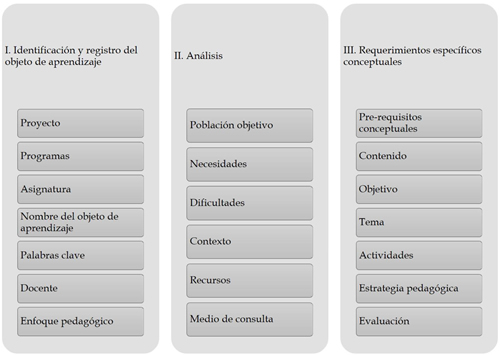
Figure 2. Structure of the techno-pedagogical script.
Likewise, an analysis of the contents and bibliographic references was carried out for the design of the LO. The objective of the topic was established, which was to identify the different types of scopes that research can have. To do this, the presentation of the topic, information related to theoretical concepts, which included the definition and classification of the scopes of research, an explanatory video, learning activities that included true/false questions, and a section to relate concepts in which different research was exemplified and the student had to select the type of scope were included. Finally, all bibliographic references on the subject were included. In Figure 3, the layout of the LO is presented.
Source: self-made, 2019.
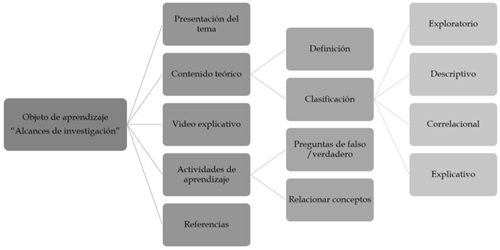
Figure 3. The layout of the LO.
Development: for the development of the LO, the teacher of the subject was trained in the use of the H5P platform. Once the LO was developed, the teacher programmed the date and time when the resource would be available in his virtual classroom. In Figure 4, one of the activities of the LO is observed.
Source: self-made, 2019.
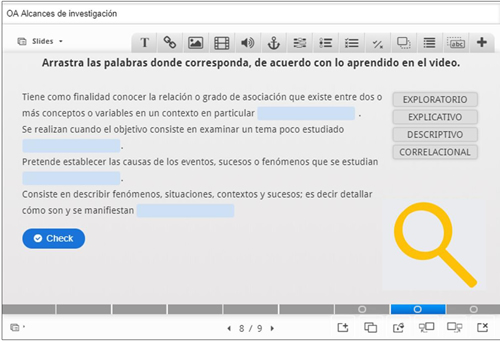
Figure 4. Design of activity of relating concepts.
Implementation: the LO was exposed to piloting in the 2019-1 cycle (January - July) to the sample of students. Students had access to this resource within the virtual classroom that they commonly use as support for their classes. Initially, the teacher applied a diagnostic pre-test that contained ten multiple-choice questions on the subject. Subsequently, he presented the learning object "research scopes". Once the time of use of the learning object had ended, the students were asked to take the post-test that contained the same ten questions of the diagnostic test.
Evaluation: The evaluation of the learning object was carried out according to the four dimensions mentioned above, for this the students were asked to open the link that led to the web questionnaire. The most important findings are shown in the results section.
4. RESULTS
This section presents the most relevant results on the evaluation of the learning object from the dimensions of usefulness, integration, impact on learning, and characteristics of the object. One of the initial questions of the questionnaire had the objective of identifying if the student presented any type of technical problem when using the learning object.
Source: self-made, 2019.
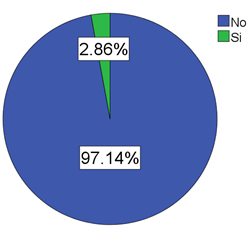
Figure 5. Problems in the management of the learning object.
In Figure 5 it is observed that 97.14% of the students had no problems when using the learning object, however, there were some inconveniences such as: “it took time to load the video of the learning object” and “I could not find the access link to the learning object”. It is important to mention that these problems are alien to the content and programming of the learning object. However, they must be taken into consideration for the instructional design of the activities by the teacher.
Through the use of percentage frequency distribution tables, the results obtained in each of the categories are presented. Table 4 shows the results of the category "usefulness of the learning object", wherefrom the perspective of the students it was useful, however, it is necessary to review the self-assessment exercises since 12% consider that it did not help them in their learning. This particular outcome provides an area of opportunity to improve the activities included in the learning object. Likewise, the best-evaluated items in this dimension were the ease of navigation of the learning object with 99% positive responses and the clear concepts and languages used in the learning object with 100% positive responses.
Table 4. The usefulness of the learning object.
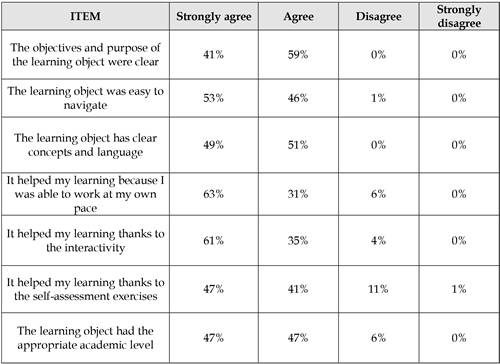
Source: self-made, 2019.
Table 5 now shows the results of the category of integration of the learning object, where it is observed that 99% agree to some degree on the inclusion of LOs in other courses. Likewise, 94% consider that the learning object is well related to the course subjects.
Table 5. Integration of the learning object.

Source: self-made, 2019.
Table 6 shows the results of the category related to the impact on learning. A very positive assessment of the category is observed, however, 11% of users consider that it did not help them understand the topic, and 7% that it did not contribute to the fulfillment of the subject program.
Table 6. Impact on learning.
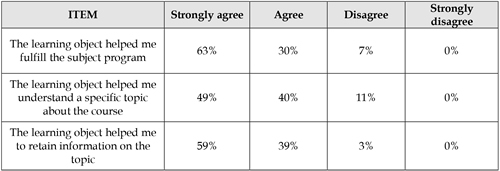
Source: self-made, 2019.
Next, in Table 7, the last category evaluated by the students in this research is presented, which has to do with the characteristics of the learning object. It is observed that 95% of the students agree or strongly agree on the visual, audio, and text characteristics included in the learning object. On the other hand, 13% mentioned that they had difficulties in accessing the learning object.
Table 7. Characteristics of the learning object.

Source: self-made, 2019.
In general, positive assessments were obtained in the four categories of evaluation of the learning object. To identify the best-evaluated category, the responses were grouped as positive, those with a selection of strongly agree and agree; and in negative, those with a selection of strongly disagree and disagree. In Figure 6, the overall results by category are presented. It is worth noting that the category that presents an area of opportunity to make improvements to the resource is the one related to the image, video, and text characteristics, which presents 8% of negative responses from the students. Likewise, the best-evaluated category was integration with 96% of positive responses.
Source: self-made, 2019.
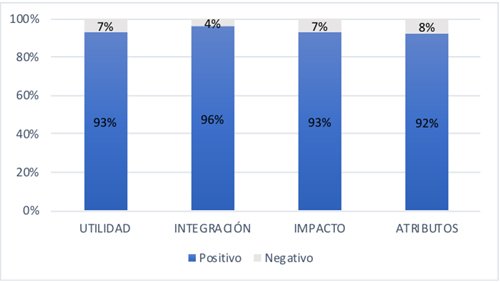
Figure 6. Overall results by category.
In the final part of the learning object assessment, the students answered two open questions. Using this type of question allows not to influence the response of the subjects, it opens the range of answer possibilities. To perform an analysis of these questions, the subjects' responses with the greatest tendency were first identified. Subsequently, the responses were coded and grouped according to the following criteria.
When performing the word count to the answers to the two open questions using the ATLAS.ti software, it was possible to know that several categories had only two frequencies. Therefore, these were reduced to four categories per question. The first question was what do you think would be the benefits for the student by having more learning objects in class? Table 8 shows the categories found for the question “about the benefits of having more learning objects”. It can be seen that these categories are mainly associated with “impact on learning”.
Table 8. Benefits for the student.

Source: self-made, 2019.
Using the same analysis tool, the results were obtained from the second open question of the questionnaire, which was: what do you think would be the benefits for the teacher, by having more learning objects in class? Table 9 shows the results of the categories found in the analysis. These categories permeate the "teaching process" since they consider that the learning object allows a better explanation of a topic and thus reinforce their knowledge.
Table 9. Benefits for the teacher.

Source: self-made, 2019.
Figure 7 shows a diagram of the benefits perceived by university students and the authors that corroborate these findings in other research.
Source: self-made, 2019.
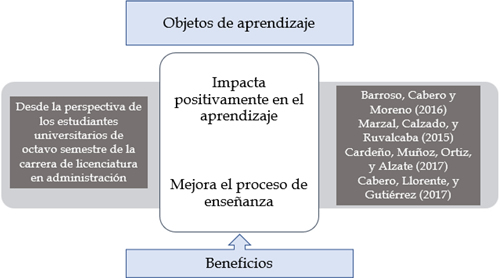
Figure 7. Perceived benefits of LOs.
5. DISCUSSION
After performing the analysis of the results in the present research, some important aspects related to the objectives that were set were revealed. The ADDIE instructional design model allowed to design and develop, in an orderly manner, the content and activities of the learning object, which agrees with what was presented by (García, 2015; and Díaz, Schiavoni, and Amadeo, 2011).
The descriptive statistics presented in the results show that the students who participated in the study would recommend the inclusion of more LOs. Likewise, the students perceived the learning object as easy to use and with very clear objectives. On the other hand, they also consider as an important characteristic of the learning object, being able to work at their own pace, that is, being able to visit the resource, move forward and backward in its content, and even conclude it or visit it again. An area of opportunity found in the study has to do with the self-assessment exercises included in the learning object since 12% of the students considered that these were not helpful for learning. This represents a challenge for future teachers who wish to develop these types of materials and who can build self-assessment activities that are more stimulating and meaningful for students.
On the other hand, 7% of the students considered that the learning object did not contribute to the fulfillment of the program, which has to do primarily with two reasons, the fact that the teacher decided not to assign a grade to the learning object and that one of the limitations of the study was that the topic addressed in the learning object was relatively short, which did not motivate its use for a longer period. The teachers will need to decide whether these types of activities are used solely as reinforcement and/or self-study material, or as an activity that forms part of the final grade of the course.
13% of the students who stated that they had some kind of difficulty in accessing the learning object, had problems because they did not remember their username and/or password to access the LMS. An alternative solution to this type of problem is to publish LOs as Open Educational Resources within an institutional repository, as some institutions in Europe, the United States, and Latin America have been doing.
The previous results show that the strategy presented to create LO can be implemented in all the courses taught in the University Administration program and thus have a repository that is available to students of all semesters, which would impact in active learning and self-learning of students would be promoted. Likewise, the implementation strategy, the evaluation, and the tool presented in this work could be used by other institutions for the production of their LOs.
Among the comments mentioned by the students in the open questions, the following stand out: improve learning, better understand a topic, facilitate teaching, and reinforce knowledge, which agrees with Cardeño, Muñoz, Ortiz, and Alzate (2017), who mention that LOs can help promote self-study, reinforce knowledge seen in class, motivate learning, and improve student academic performance. Besides, a high level of educational satisfaction (Cabero, Llorente, and Gutiérrez, 2017).
6. CONCLUSIONS
For the particular case of the intervened educational institution and the population of students, the LO obtained generally positive assessments, according to the LO assessment questionnaire tool. In which, the answers to the questions related to ease of navigation, the recommendation of the learning object, and the relation of the object with the course topics stand out from the rest. It should be noted that H5P is compatible with Moodle and other educational platforms, this feature makes H5P stand out from other competitors because users do not have to migrate their courses to other learning environments, that is, they can continue with their courses hosted in the LMS of their choice and gradually incorporate LO, without affecting the previous structure and resources within the course. The above opens a wide range of options for teachers, regardless of the level of studies, due to the possibility of creating virtual communities for the exchange of this type of content.
On the other hand, some characteristics of the learning object stand out, which were considered by the study population as very important. These characteristics are interactivity, visual components like images, audio, and video, anytime access, and work at their own pace. The above indicates that the study population has a preference for using visual, interactive, dynamic, and accessible content from anywhere and at any time. With the emergence of emerging platforms and technologies such as H5P, teachers can now develop and implement their own LOs, mainly due to the great ease and operability of new software tools, which do not require knowledge of a specialized computer programming language to create attractive and innovative digital materials. For the development of the learning object, the H5P tool was a good solution since it is easy to use and does not require programming knowledge.
7. REFERENCES
AUTHORS:
Sergio Ramón Rossetti López
Maestro en Gestión de Tecnologías de la Información e Ingeniero en Sistemas Computacionales. Durante 16 años ha impartido clases sobre informática, estadística, programación, tecnologías de la información y bases de datos en diversas universidades en México. Miembro de la academia de investigaciones organizacionales en la Universidad de Sonora. Miembro de la academia de tecnologías de la información en la Universidad Estatal de Sonora. Estudiante de Doctorado en Innovación en Tecnología Educativa por la Universidad Autónoma de Querétaro y becario del Consejo Nacional de Ciencia y Tecnología (Conacyt).
sergio.rossetti@unison.mx
Orcid ID: https://orcid.org/0000-0002-5524-8674
Google Scholar: https://scholar.google.com/citations?hl=en&user=Zp-QZksAAAAJ
Ma. Teresa García Ramírez
Profesora e investigadora en la Facultad de Informática de la Universidad Autónoma de Querétaro, donde ha coordinado proyectos de creación o actualización de programas académicos. Ha dirigido tesis de licenciatura, maestría y doctorado, y ha participado en eventos académicos nacionales e internacionales. Su participación en proyectos le ha permitido publicar sus resultados en eventos y revistas en México, Latinoamérica y Asia. Al igual, ha colaborado como evaluadora de programas académicos nacionales y en comités editoriales de varias revistas nacionales e internacionales.
teregar@uaq.mx
Orcid ID: https://orcid.org/0000-0002-5524-2002
Google Scholar: https://scholar.google.com/citations?user=Fz49LVkAAAAJ&hl=es
Isaac Shamir Rojas Rodriguez
Doctor en Desarrollo Regional por el Centro de Investigación en Alimentación y Desarrollo A. C. (CIAD A. C.). Ex becario del Consejo Nacional de Ciencia y Tecnología (Conacyt). Miembro del Sistema Nacional de Investigadores (SNI MÉXICO). Egresado de la Maestría en Calidad de la Universidad La Salle Noroeste. Formado como Ingeniero en Sistemas Computacionales. Actualmente me desempeño como Profesor Investigador del Departamento de Administración de la División de Ciencias Económicas y Administrativas de la Universidad de Sonora. Profesor de las asignaturas. Maestría estadística para la administración, seminario de producción y estudios independientes. Licenciatura; administración de la producción, cultura y gestión organizacional.
shamir.rojas@unison.mx
Orcid ID: https://orcid.org/0000-0002-0798-1476
Google Scholar: https://scholar.google.com/citations?hl=en&user=hLdAbk0AAAAJ